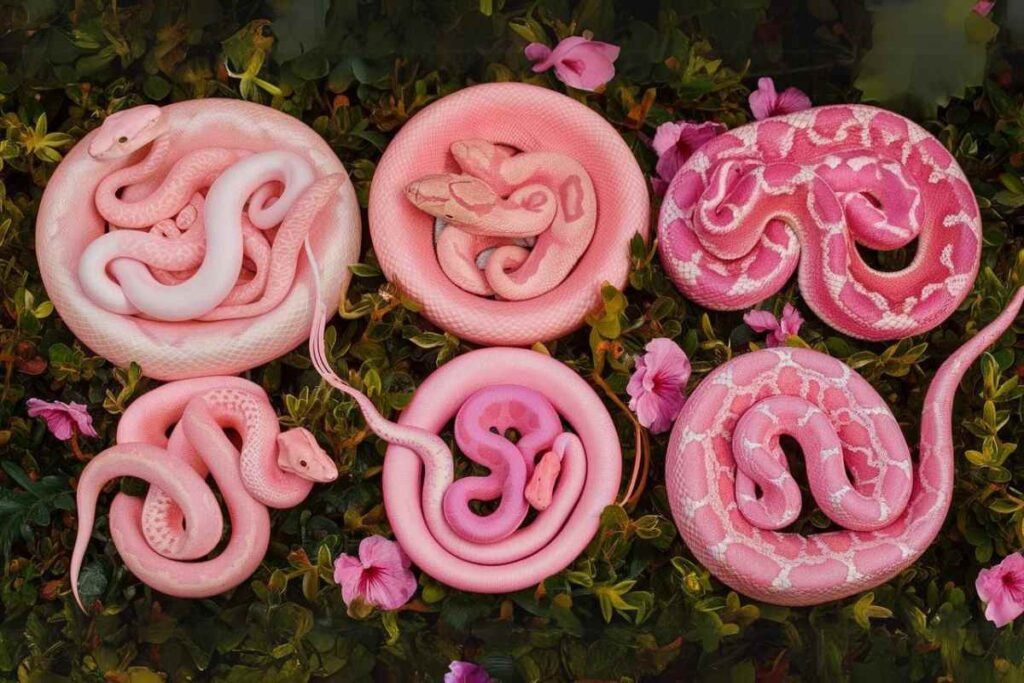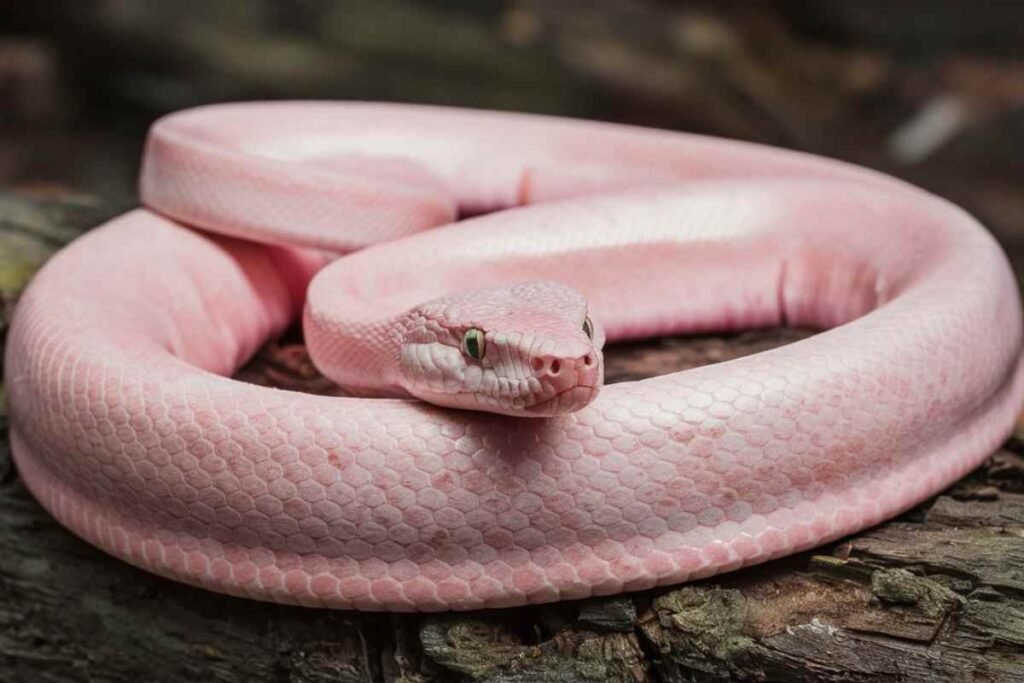Table of Contents
Introduction
Snakes are fascinating creatures that come in a variety of colors and patterns, each adapted to its unique environment.
Among these, the concept of a “pink snake” sparks curiosity and interest.
In this article, we’ll delve into the existence, characteristics, habitats, and cultural significance of pink snakes.
Existence of Pink Snakes
When we talk about pink snakes, it’s important to clarify what we mean. Naturally occurring snakes are extremely rare, but they do exist.
The pink hue can be a result of genetic mutations, albinism, or erythrism (an unusual reddish pigmentation).
Types of Pink Snakes

Worm Snakes (Leptotyphlopidae)
Some species of worm snakes exhibit a pinkish hue. These snakes are small, slender, and often mistaken for earthworms.
They are usually found in North and Central America and are non-venomous, feeding primarily on ants and termites.
Corn Snakes (Pantherophis guttatus)
Corn snakes are popular in the pet trade and can come in a variety of color morphs, including pink. Selective breeding has led to the development of beautiful pink variants.
These snakes are native to the southeastern United States and are known for their docile nature.
Rosy Boas (Lichanura trivirgata)
As the name suggests, some rosy boas can have a pinkish hue. These snakes are native to the southwestern United States and northwestern Mexico.
They are small, slow-moving, and non-venomous, making them popular pets.
Albino Snakes
Albino snakes, due to their lack of pigmentation, can sometimes appear pink. This is particularly true for albino corn snakes and Burmese pythons.
The pink coloration is often due to the underlying blood vessels showing through their translucent skin.
Characteristics of Pink Snakes

Pink snakes, like their more commonly colored counterparts, exhibit a variety of characteristics:
Size and Shape
The size and shape of pink snakes can vary greatly depending on the species. Worm snakes are typically small, while corn snakes and rosy boas are medium-sized.
Behavior
Most pink snakes are non-venomous and are often considered docile, making them suitable pets. They are usually nocturnal and prefer to hide under debris or burrow into the ground.
Diet
Their diet can include small mammals, birds, eggs, insects, and other invertebrates. Pet pink snakes are typically fed rodents.
Lifespan
In captivity, these snakes can live from 10 to 20 years, with their lifespan heavily influenced by the quality of care they receive.
Proper diet, housing, and medical attention are crucial factors in ensuring they reach their maximum longevity.
Habitat and Distribution

Natural pink snakes are found in various habitats across the globe:
Worm Snakes
Worm snakes are typically found in a variety of environments, including forests, grasslands, and gardens, where they thrive in moist, loose soil.
These habitats are mainly located in the Americas, providing the cover and food sources these small, burrowing snakes require.
Corn Snakes
In the southeastern United States, corn snakes inhabit overgrown fields, forest openings, trees, and abandoned buildings.
They are highly adaptable, often seeking out these diverse environments for shelter and hunting opportunities.
Rosy Boas
Rosy boas prefer rocky terrains, deserts, and scrublands in the southwestern United States and northwestern Mexico.
These environments provide the necessary conditions for their burrowing behavior and help them regulate their body temperature.
Care for Pet Pink Snakes

Pink snakes, particularly those bred for the pet trade, require specific care:
Housing
A secure enclosure with appropriate space, substrate for burrowing, and hiding spots.
Temperature and Humidity
Proper temperature gradients (warm side and cool side) and humidity levels suited to the species.
Diet
Regular feeding of appropriate-sized prey items. Fresh water should always be available.
Handling
Gentle handling to build trust and reduce stress for the snake.
Cultural Significance and Symbolism

Snakes, including pink ones, hold various symbolic meanings across cultures:
Transformation and Rebirth
Snakes shed their skin, symbolizing renewal and transformation.
Fertility and Healing
In some cultures, snakes are associated with fertility and healing due to their phallic shape and medicinal uses.
Mysticism and Knowledge
Snakes often represent mysticism, knowledge, and the underworld in mythology.
Conservation and Ethical Considerations
While snakes in the wild are rare and not typically the focus of conservation efforts, it’s essential to consider the ethical implications of breeding and keeping exotic pets.
Responsible pet ownership, avoiding wild-caught specimens, and supporting reputable breeders contribute to the well-being of these animals.
Conclusion
In conclusion, pink snakes whether found in the wild or selectively bred, offer a unique glimpse into the diversity and beauty of the reptile world.
Their rarity and striking appearance make them fascinating subjects for both enthusiasts and pet owners alike.
Understanding their characteristics, habitat needs, and the ethical considerations of keeping them as pets is crucial for their preservation and well-being.
By appreciating the uniqueness of snakes and committing to responsible care and conservation practices, we can ensure these captivating creatures continue to thrive and enchant future generations.
FAQs
Do pink snakes exist in the wild?
Yes, but they are extremely rare and usually result from genetic mutations, albinism, or erythrism.
What species of snakes can be pink?
Some species include worm snakes, corn snakes, rosy boas, and albino variants of other species.
Are pink snakes venomous?
Most pink snakes are non-venomous and are considered docile, making them suitable as pets.
Where are pink snakes typically found?
Depending on the species, they can be found in North and Central America, the southeastern United States, and the southwestern U.S. and northwestern Mexico.
Can I keep a pink snake as a pet?
Yes, many pink snakes, such as corn snakes and rosy boas, are popular in the pet trade.
What do pink snakes eat?
Their diet includes small mammals, birds, eggs, insects, and other invertebrates. Pet pink snakes are usually fed rodents.
How long do pink snakes live?
In captivity, pink snakes can live from 10 to 20 years, depending on the care they receive.
What kind of habitat do pink snakes need?
They need a secure enclosure with appropriate space, substrate for burrowing, hiding spots, proper temperature gradients, and humidity levels.
Do pink snakes have any cultural significance?
Yes, snakes, including pink ones, symbolize transformation, fertility, healing, mysticism, and knowledge in various cultures.
Are there any ethical concerns with keeping pink snakes as pets?
Yes, it’s important to practice responsible pet ownership, avoid wild-caught specimens, and support reputable breeders to ensure their well-being.


